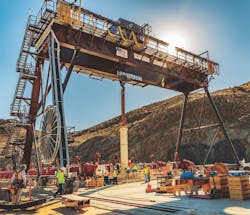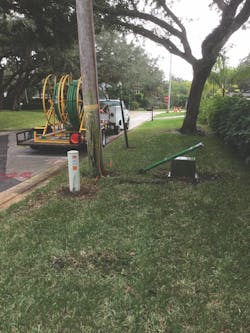About the author:
Thomas Renner writes on building, construction, manufacturing and other trade industry topics. Renner can be reached at [email protected].
Numbers paint a dire picture of water consumption in Las Vegas. The metropolitan region has a population of 2.2 million, and the average household uses 222 gallons of water per day. That results in approximately 489 million gallons of daily water consumption.
That is a lot of water, especially for a region that averages just greater than 4 inches of rainfall every year. That water is becoming even more scarce. In a stretch that ended in January 2018, Las Vegas went 116 straight days without rain, its longest stretch ever. In 2019, the region had a “good” year with rainfall netting more than 7 inches. In many U.S. communities, that figure is merely a good soaking from a one- or two-day tropical storm.
The Southern Nevada Water Authority adopted conservation measures in 2003, and the programs have dramatically reduced water consumption. The community used 27 billion gallons less in 2018 than in 2002, even as the population increased by 690,000 residents. The conservation measures include limiting watering days to one day per week, turf limits, residential water efficiency programs and even surcharges on golf courses that exceed their water budget.
While conservation is helping reduce water consumption, Southern Nevada is taking even more dramatic steps. This year, it will start the operation of a $650 million project that provides a water safety net for city residents. The Lake Mead Low Lake Level Pumping Station will have the capacity to deliver up to 900 million gallons a day to two water treatment facilities. The project is one of the most sophisticated, expensive and largest pumping stations in the world. It will also help make sure residents of Las Vegas will not have to worry about running out of water.
The Mighty Colorado
The Las Vegas region draws most of its water from the Colorado River, but that too is causing concern in the region. American Rivers, a nonprofit group whose mission is to protect wild rivers and restore damaged rivers, said in 2017 that the lower Colorado River is one of the most-endangered rivers in the U.S.
“While the river is not going to disappear, there is a very real possibility that over the next several years water delivery will be cut to some users because we collectively use more water than the river can provide,” the organization said.
The Colorado River feeds into Lake Mead, which serves as the source of drinking water for the Las Vegas metropolitan region. The lake has dropped more than 130 feet since January 2000, and the federal government is projecting a high probability that Lake Mead water levels may fall below 1,075 feet in 2021.
Construction of the Low Lake Level Pumping Station started in 2015. The $650 million project included a 26-foot diameter access shaft more than 500 feet deep, a 12,600 square foot underground cavern and a forebay with 34 vertical shafts, each unit 500 feet deep and 6 feet in diameter, to accommodate the station’s submersible pumping units.
“It is a backup, redundant pumping station to use in the event our other two pumping stations are unable to pump due to lowering lake levels,” said Erika Moonin, SNWA project manager. “The [U.S.] Bureau of Reclamation is the governing body that forecasts watershed along the Colorado River. It will take many years of incredible snowpack for Lake Mead, Lake Powell and other reservoirs to recover from this long-standing drought and the consequences of climate change.”
First Steps
Among the first steps in the project was to create a forebay, a 12,500 square foot cavern that is 500 feet beneath the pumping station. Pumps draw water from the forebay, and the water then enters the header pipe and flows through two large-diameter aqueduct systems to deliver water to two treatment plants.
Twenty-two low lift pumps will deliver raw water to the Alfred Merritt Smith Water Treatment Facility, and 12 high-lift pumps will deliver raw water to the River Mountains Water Treatment Facility. The water is treated with ozone and then goes through a filtration system before entering the transmission system and eventually, the homes and businesses in the Las Vegas valley. Creation of the forebay and shafts proved to be one of the most challenging tasks of the entire project, Moonin said.
“The rock is hard but fractured, and water flows through the fractures with direct connectivity to Lake Mead,” Moonin said. “In order to proceed with excavating the underground caverns and well shafts in these challenging work conditions, a significant grouting program was used to prepare the ground for drilling of the well shafts and drill-and-blast excavation of the forebay.”
Powerful Pumps
The pumps, manufactured by Indar, are the deepest submersible pumps in the world.
“They go all the way down each 500-foot well shaft to below the waterline, rather than sit on the waterline. They push the water up the column pipe and into the header pipe, which leads to the dual aqueduct system,” Moonin said.
The pumps were lowered into place with a 220-ton gantry crane. Each low-lift pump weights about 68 tons, and each high-lift pump weights about 79 tons.
“The drop of Lake Mead made it necessary to install pumps in such depth,” said Maria Elena Rodriguez, Indar water engineering director. “A traditional vertical turbine solution was not feasible to operate reliably in those depths.”
Each low lift pump is 23 feet long and can pump 30 million gallons of water per day, according to Moonin. The high lift pumps are 28 feet long and can also pump 30 million gallons per day.
“That’s more than 250 bathtubs every second,” said Dirk Wulf, project manager at Indar.
The Indar pumps consist of multi-stage centrifugal pumps directly coupled to a submersible electric motor in an inverted configuration and is designed for permanent submersible operation of clean water. The motor includes a cooling shroud that ensures the cooling flow with the discharged water. The pumps are set with 13,800-volt motors that range from 3,150 to 5,200 horsepower.
Closing the Door on Water
Valves at the pumping station are protected by 12 floor doors manufactured by The Bilco Co. from Connecticut. The doors are strategically placed on the project’s vaults, which house and provide access to large diameter valves. The doors are reinforced for AASHTO H-20 wheel loading to withstand vehicular traffic.
Single- and double-leaf doors were used in the project and will allow workers to access valves that require adjustment and perform maintenance on the pumps. Although the doors are quite large and heavy, they are supplied with Bilco's engineered lift assistance to ensure safe and easy one-hand operation. Foster Engineered Products, a Bilco sales representative in the area, procured the doors for Barnard, the general contractor. Parsons served as the construction manager on the project.
“There are conduits and drain lines that required access,” said Tyler Askin, Barnard’s project engineer at Lake Mead. “The doors were a product that one of our suppliers had used in the past and had the most experience with, and the specifier thought they would be a good choice, especially for this application.”
Combating Drought
The Lake Mead Low Lake Level Pumping Station addresses the needs in Las Vegas and the surrounding community, but there is significant concern around the region about the Colorado River and its reliability as a water source. One study found that higher temperatures due to climate change had reduced the flow of the Colorado River 19% below the average from 1906 to 1990. The study projected additional warming could reduce flows by 20% in 2050 and up to 35% by 2100.
In addition to climate change, overuse in the region is also a major problem. Leaders from seven states signed a Colorado River Drought Contingency Plan in May of 2019, a sweeping new water management agreement. The plan, however, only runs through 2026.
The Lake Mead Low Level Pumping Station is one of the first steps toward making sure residents in Southern Nevada will have water today, tomorrow and well into the future. It might also be a project that will help other communities find creative solutions to combat water shortages and keep the world’s most precious natural resource streaming to residents.
“It’s really an unsung project, but it’s important for the Las Vegas community to guarantee their water supply,” Askin said. “It’s one of those projects a lot of people are unaware of. It’s not alongside a highway where you can see progress every day. Water’s not something people think about it until they don’t have it. This will help make sure that doesn’t happen.”
About the Author
Thomas Renner
Thomas Renner writes on building, construction, engineering and other trade industry topics for publications throughout the United States.


